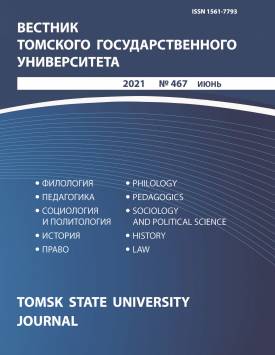Valkyrian Myth in the Works by Andrey Bely
The aim of this article is to study the so-called “Valkyrian myth”, i.e. the plot and motif complex related to the mythological figure of Valkyrie, in the artistic world of Andrey Bely. The article aims to establish the text corpus where the image of Valkyrie appears, to identify the sources affecting the Valkyrian myth in Bely, to describe the constant features and the evolution of its creative reception by the writer, and, finally, to define the specificity of this figure and the related plot in Bely’s works. The author of the article uses the method of structural and semiotic analysis, the comparative method, involves mythopoeic analysis, applies some techniques of gender studies. The Symbolist text is read through the optics of “life-building”, the interaction of art, social action, and biographical reality. The author demonstrates that the Valkyrian myth in Bely’s works unfolds in the close creative dialogue with Alexander Blok and develops the theme of Blok and Bely as “literary doppelgangers” who used the same set of plots, motifs, and images (until 1908), which also includes Valkyrie Brunnhilde. However, while Blok, who does not reproduce the story of Nibelungs in its entirety, still addresses its various episodes, Bely is interested in a single one - that of sleeping Brunnhilde’s rescue by Siegfried, who braves the ring of fire; the writer links this episode directly to the gnostic idea of the imprisoned, enchanted, and sleeping World Soul waiting to be rescued by a hero. Moreover, the specific nature of Bely’s creative reception of the Wagnerian plot expresses itself in the blending of the two different exploits of Siegfried - the awakening of Valkyrie and the slaying of the dragon Fafnir, which Bely perceives exclusively in the apocalyptic, eschatological light. It is curious that, unlike Blok, Bely brings to the fore the Brunnhilde who overshadows Siegfried. In his works, the main pair of characters who almost in all cases appear together are not Brunnhilde and Siegfried (lovers), but Brunnhilde and the Dragon (enemies). Though both Bely and Blok recreate two variants of the main symbolist myth of rescue, Bely ultimately attributes the primary role to the heroine - it is the “Woman clothed in the Sun” who slays the ancient Serpent; she becomes the dragonslayer and takes up the role of the chosen hero. Both Bely and Blok perceive Brunnhilde mystically, in the following chain: World Soul - Sophia (and Achamoth) - “Woman clothed in the Sun”, even Virgin Mary. Though Blok’s interpretations of the Wagnerian plot are more diverse and occur not only in essays but also in his lyrical works, the “chronological” priority lays with Bely. Both Blok and Bely mention Brunnhilde the most during the period of their intensive interactions. After these interactions become sparse, this figure and the related plot are called into question, but Bely is
Keywords
Valkyrie, Brunnhilde, Siegfried, Andrey Bely, R. Wagner, H. Ibsen, A. Blok, female warrior, Apocalypse, genderAuthors
| Name | Organization | |
| Zuseva-Ozkan Veronika B. | Gorky Institute of World Literature of the Russian Academy of Sciences | v.zuseva.ozkan@gmail.com |
References

Valkyrian Myth in the Works by Andrey Bely | Vestnik Tomskogo gosudarstvennogo universiteta – Tomsk State University Journal. 2021. № 467. DOI: 10.17223/15617793/467/2
